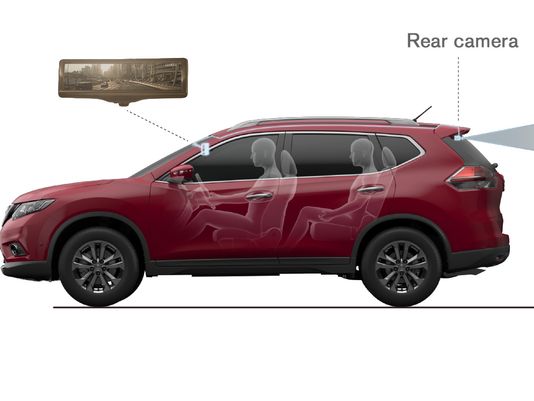Nissan's display at the New York auto show includes a camera that can take the place of the car's inside rear-view mirror.
The "smart rearview mirror" is exhibited on a Nissan Rogue SUV, but isn't likely for showroom models soon. It makes a real-life debut on the automaker's ZEOD RC, an experimental race car scheduled to compete in the 2014 24 Hours of Le Mans.
Still, it's a breathtakingly sudden view of technology that could figure into something that automakers only earlier this year began lobbying for -- permission from the government to replace outside rear-view mirrors with cameras and screens.
That would trim weight and wind resistance as part of the many incremental moves car companies must make to meet the federal mileage standard of 54.5 mpg in combined city'highway driving in 2025. That's a lab-test number, and works out to, very roughly, 39 mpg on the window-sticker city/highway rating.
Nissan's new mirror system doesn't replace the outside mirrors. It uses a very-high resolution camera mounted high on the rear of the vehicle to send a signal to the sophisticated inside rear-view mirror, which is modified to serve as a view screen or a conventional glass mirror.
The driver can switch between the view provided by the conventional glass mirror, or the rear high-mounted camera, whichever suits.
Assuming it works properly, it'll be evidence that a camera can show what's behind the car as well as a regular mirror can. And that's the key to unlocking the system automakers now want.
The plan would be to mount tiny cameras on the outsides of vehicles, piping what they see to inside screens, probably mounted high and forward on the door panels, or somewhere nearby, where the driver's eye is accustomed to looking before changing lanes or moving through traffic.
Volkswagen already has an experimental, super-high-mpg car with a prototype of such a camera system. It's the $150,000-plus, 200-mpg diesel-electric hybrid XL 1, sold only in Germany in tiny numbers.
Nissan's setup suggests the technology is available for crafting the kind of rear vision that could make drivers comfortable relying less on conventional mirrors and more on cameras and screens.
Nissan says it'll try the "smart rearview" on a racer first because, "Under the harsh driving conditions in the world of motorsports, retaining a clear view for the race driver is of utmost importance."


